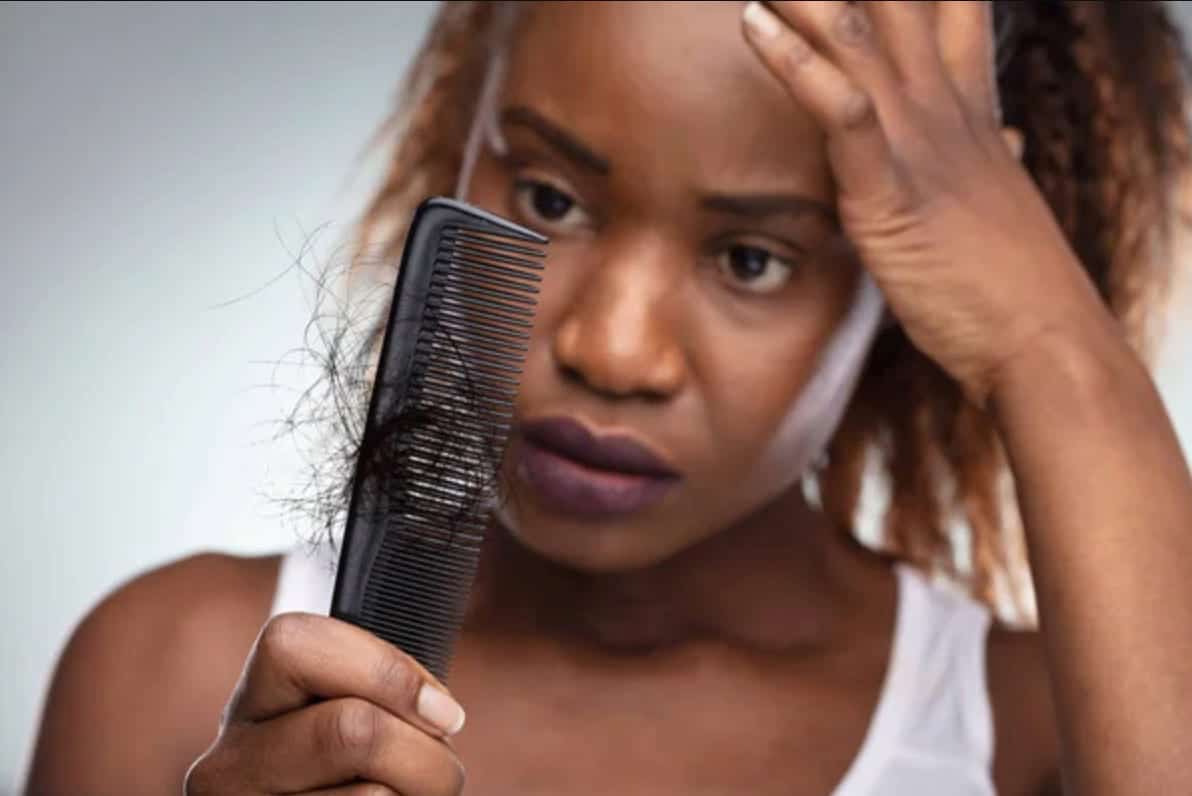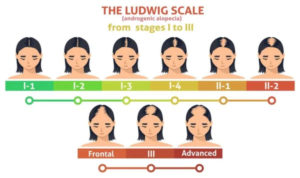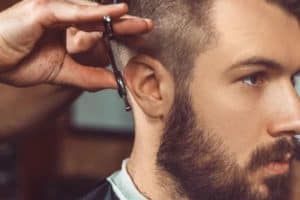Hair loss is a prevalent problem across the UK affecting people of all genders, backgrounds, and ethnicities. Although hair loss tends to evoke images of men with crown balding and receding hairlines, it also affects women just as much.
What’s even worse is that black women have been shown to experience higher rates of hair loss when compared to the national average. Did you know that a study conducted by the American Academy of Dermatology (2016) found 50% of black women experience hair loss at some point in their adult life? That’s almost 10% high than the national average of women!
On this page, you’ll be able to find all the reasons why hair loss is so prevalent across a number of afro hair communities and why women may be more prone to hair loss than men.
What is afro hair loss and why may it affect me?
Did you know humans lose between 50 and 100 hairs a day? This is typical and just a part of the hair follicle life cycle. However, when we talk about hair loss, this is usually because there is hair does not naturally regrow after shedding in the Telogen phase. In afro hair, regrowth may not occur for a number of reasons, but more to come on that later…
Typically, Afro hair is more delicate than other hair types as it is often more prone to hair breakages as a result of lack of moisture.
If you’ve got afro hair, the first step you can take is investing in a high quality shampoo and conditioner and use this regularly to slow down the hair loss process.
If you feel like you’re suffering with afro hair loss, don’t worry. All of our treatments are suitable for afro hair. From thickening the hair on the crown or reshaping a receding hairline, we’ve got you covered!
Why do black women experience hair loss so frequently?
There are several different explanations as to why hair loss is so prevalent in black women. At Harley Street Hair Transplant Clinics, we’ve devised this exhaustive list to help you diagnose why you may be suffering with hair loss and what you can do to slow, maybe even stop, this process.
Traction Alopecia / Scarring Alopecia
One problem facing women more than men with afro hair is a specific type of hair loss hat is typically associated with longer hair styles. In an article published by John Hopkins Medicine, Dr. Crystal Aguh suggests one of the main causes of hair loss in black women to occur as a result of traction alopecia.
Traction alopecia often occurs as a result of excess stress that is put on the hair as a result of environmental factors. In many cases, hair loss may occur as a result of chemical/heat treatments for the hair, or excessively tight hairstyles (braids, dreads, extensions etc).
If you think you may be experiencing traction alopecia, Dr Aguh recommends the following to slow or stop hair loss:
- Ask your hairdresser or stylist for looser braids or dreadlocks.
- Shorten the amount of time you have your hair in braids, extensions, or weaves.
- Reduce heat styling through hair dryers and curling tongs.
Should you still experience some symptoms of hair loss, this may be a result of something genetic or even more serious. In any case, be sure to book a free consultation with us and begin your hair restoration journey! We offer a range of long-term affordable hair transplants for all of our patients.
Female Pattern Baldness
Rates of female pattern baldness amongst African American women are around the same as the general population, affecting 40% of women by age 50 (National Library of Medicine 2015). As its name may have already given away, this is where hair loss occurs in a typical pattern over a period of time.
Sadly female pattern baldness does cause permanent hair loss and hair will not regrow as it may with other conditions like scarring alopecia or alopecia areata. What is even worse is that this will progressively get more severe over time, leading many women to either wear wigs or get a hair transplant.
Typically, women suffering with female pattern baldness will experience a gradual thinning of the hair on the top of the head (specifically, the area called the mid-parting). Eventually, this will lead to total baldness in this area and it will slowly expand further across the head.
Pattern baldness requires a genetic predisposition amongst sufferers. This means you will have inherited this from one of your parents.
For more information on female pattern baldness, why not have a look at our dedicated female pattern baldness page?
Alopecia Areata
One of the most common forms of hair loss in black women is an autoimmune disorder called alopecia areata. A patient may suffer hair loss in small patches, usually the size of a 50p piece, for extended periods of time.
Alopecia areata occurs when your immune system attacks certain areas of your body. Not only can this condition affect your scalp, but other areas of your body as well.
Sometimes, if left untreated, an area affected by alopecia areata may simply grow back. This would suggest that your hair loss may be stress or diet related as a change in life circumstances can affect hair loss and growth.
The Structure of Afro Hair
The one key difference between afro and other hair types is how the roots at the hair follicle form under your skin. Whilst other hair types typically have straighter roots, afro hair has a curly root that grows in an almost helix shape.
When afro hair begins to grow, it is this difference in root that causes the different appearance to other hair types. As a result, afro hair is naturally thicker and curlier than other hair styles.
However, one problem that afro hair poses is that it can quickly become dry, resulting in hair breakages and split ends. In extension, the use of flat irons and curling tongues certainly don’t help matters, drying the hair even further and stripping its natural oils. This may well be a cause for hair loss.
How can I diagnose my afro hair loss?
If you want to spot signs of hair loss, it is definitely worth having an understanding of the different types of afro hair. If you can categorise your own hair type, you’ll be able to keep a keen eye out for the progression of your hair loss.
Whilst we generally assume afro hair to be curlier than other hair types, that is not to say there is no variation in afro styles. In fact, hair surgeons will place afro hair into one of three categories (rated A to C) based on curliness
Someone with Afro Curly Hair (A) will often have a hair style referred to as a “frizzy” or having “bouncy” curls. People with curly hair have the thickest hair follicles of all afro textured hair and, thus, the tightest curls. If you compared these hair follicles to other afro styles under a microscope, you would see that curly hair has a more compressed helix. This is what gives the thickest curls and the fullest look of all hair types. As this hair is so thick, it may be difficult to spot early signs of hair loss.
The second category, Afro Wavy Hair (B), is defined as having a consistent pattern throughout the hair. Wavy hair types are typically easier to style and transplant than curly hairs, but harder than straight hair. This is because the helix shape of wavy hair is more compact than curly hair, but less than straight hair.
Afro Straight hair (C) is the easiest of all afro hair types to categorise. It has no recognised curl or wave. Typically, patients suffering hair loss with straight hair will notice a loss of hair quicker than other styles. However, straight afro hair is typically the easiest to style and, if you choose to have a hair transplant, the easiest to implant.
If you think you may be struggling with afro hair loss and are considering a hair transplant, why not have a look at our Afro hair transplant page?
What can I do to fix my loss of hair?
There are a number of different techniques black women can do to slow down and, in some cases, even stop the effects of hair loss. As one of the most common forms of hair loss in black people is a condition that is environmentally caused, traction alopecia, one of the first things to be done is reduce the stress on hair follicles by reducing the time hair is spent in dreadlocks, braids, and with extensions.
Another way to slow down the speed of afro hair loss is keeping your hair follicles well hydrated. As well as conditioner treatments, coconut oil is a well known remedy for dry hair as it adds moisture to the roots. If you keep your afro hair hydrated, it is less prone to breakages and split ends and, thus, less likely to lead to hair loss.
Equally, if you’re struggling with a more severe form of hair loss and your hair just won’t regrow, there are two key treatments that you opt for: drug/topical treatments or a hair transplant.
- Drug Treatments – many black women come to us having already tried drug treatments such as mixodil or finasteride. These treatments are fantastic at slowing the effects of hair loss but only work for as long as you take them. This can be expensive over the long term, especially considering your mid-parting hairline is unlikely to regrow!
- Hair transplant – if you’re struggling with a more severe form of hair loss, the only long-term solution is a hair transplant. Despite being an initial outlay, a fue hair transplant will ensure that your hair is restored and will continually regrow for the considerable future!
Concluding remarks
There are a number of reasons why hair loss is highly prevalent amongst black women. In conjunction with inherited conditions (such as female pattern baldness) being similar to the wider population, styling practices may well provide an explanation as to why there is an increased amount of hair loss in this community.
If you have afro hair and think you may be suffering with hair loss, be sure to follow our guidelines laid out in this article to see if your condition gets better or worse over time. If you think you may need to have a hair transplant in the future, be sure to contact us and book your free consultation here.








